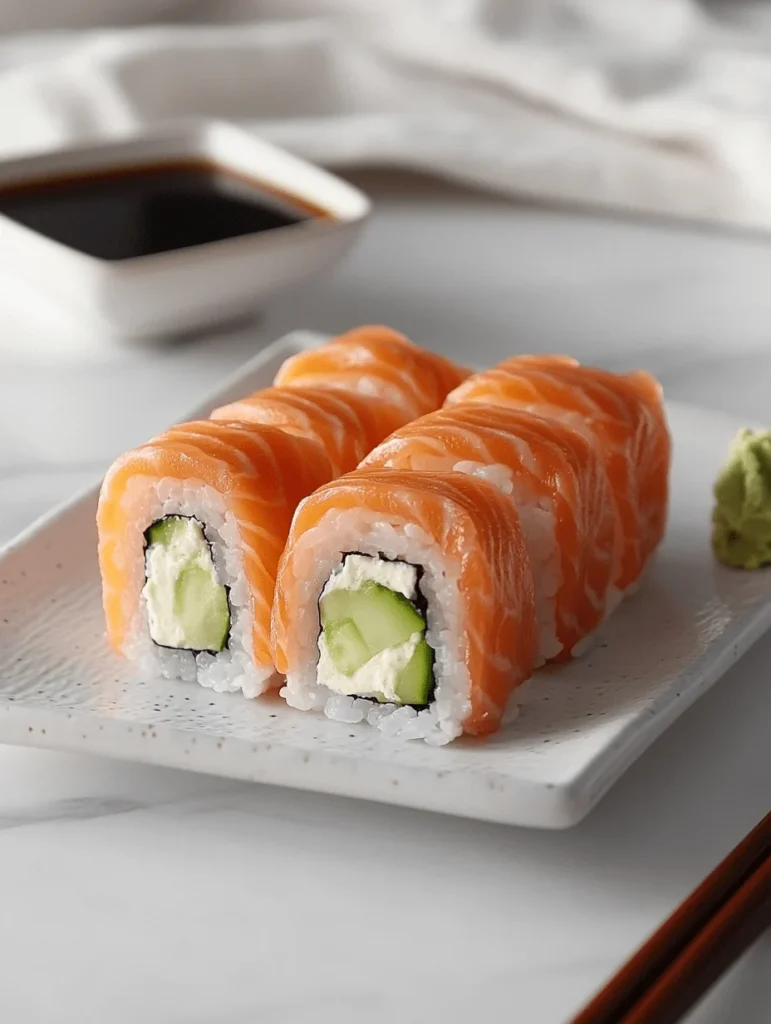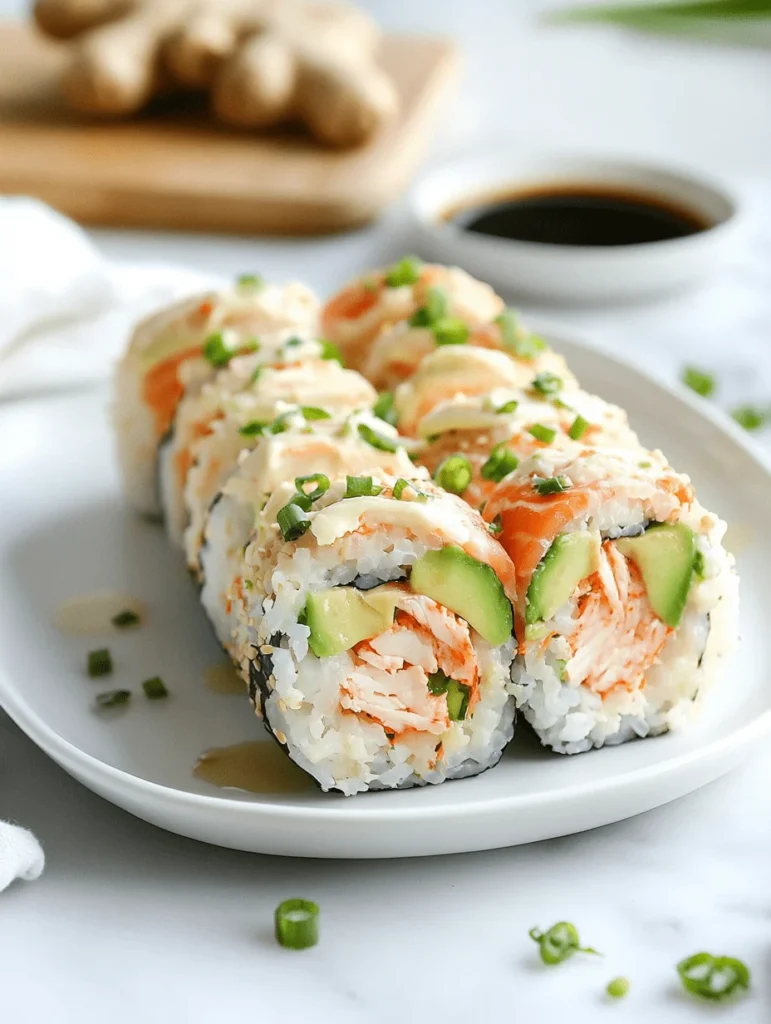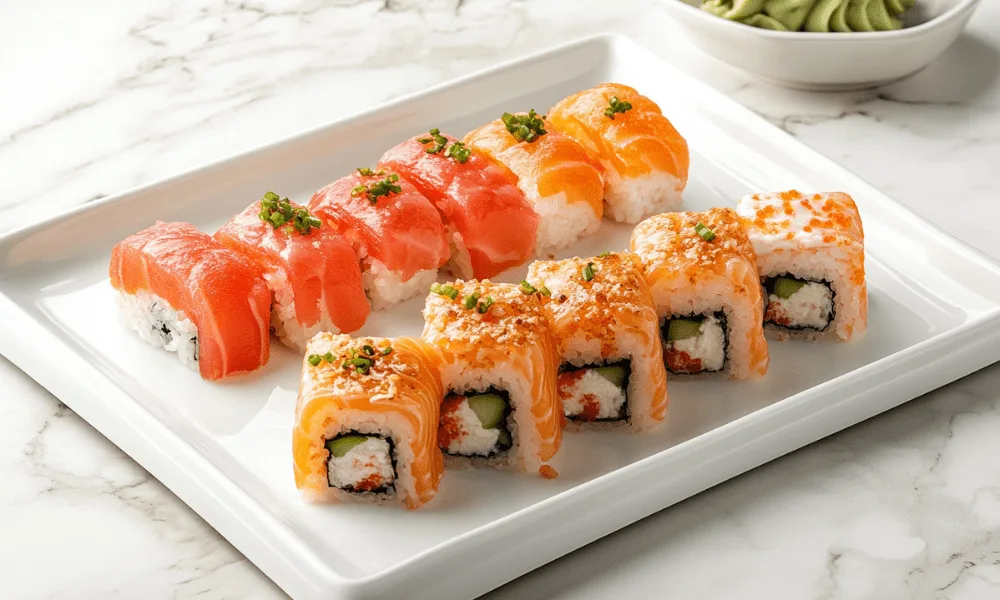Ever wondered what sets the Philadelphia roll apart from the Alaska roll? Sushi lovers often find themselves in a delightful dilemma when choosing between these two popular rolls. While they both hold a special place in the sushi world, their ingredients, flavor profiles, and even their preparation styles make them unique. In this article, we’ll dive into the delicious details and help you become a sushi expert!
Sushi Rolls: A Brief Overview
Sushi is more than just food – it’s an art form. Over the years, sushi has evolved from traditional Japanese nigiri and sashimi into creative and flavorful rolls. Two stars of the sushi roll scene are the Philadelphia roll and the Alaska roll. But before we dig into their differences, let’s take a step back and appreciate what makes sushi rolls so special.
“Sushi is like a blank canvas – with each roll, you paint a picture of taste, texture, and culture.”
The Appeal of Sushi Rolls in Modern Cuisine
Why do we love sushi rolls so much? For one, they’re incredibly versatile. You can fill them with fresh fish, creamy spreads, crisp vegetables, or even tropical fruits. Plus, sushi rolls are bite-sized bundles of joy, perfect for sharing or indulging solo. Whether you’re a seasoned sushi enthusiast or just starting your sushi journey, rolls like the Philadelphia roll and Alaska roll offer something for everyone.
Why These Rolls Stand Out Among Sushi Fans
The Philadelphia roll is known for its creamy, savory twist, thanks to the addition of cream cheese. On the other hand, the Alaska roll delivers a fresh and slightly smoky flavor, making it a hit with seafood lovers. Both rolls strike a balance between traditional Japanese techniques and modern, Western-inspired creativity.
What is a Philadelphia Roll?

The Philadelphia roll, often nicknamed the “Philly roll,” is a crowd favorite. Its signature ingredient? Cream cheese! This roll blends the smooth richness of cream cheese with the delicate texture of salmon, creating a sushi experience unlike any other.
Ingredients in a Philadelphia Roll
Here’s a closer look at what goes into a classic Philadelphia roll:
| Ingredient | Quantity |
|---|---|
| Sushi rice | 1 cup |
| Smoked salmon | 4 slices |
| Cream cheese | 2 oz |
| Cucumber | 1 small |
| Nori (seaweed) | 1 sheet |
The combination of smoked salmon, cream cheese, and cucumber gives the Philadelphia roll its trademark creamy and crisp texture. Some variations might even include avocado for an extra layer of flavor!
Origin and History of the Philadelphia Roll
Despite its name, the Philadelphia roll didn’t originate in Philadelphia. However, the use of Philadelphia-brand cream cheese inspired its name. This roll emerged in the United States as sushi chefs began experimenting with Western ingredients to appeal to a broader audience. And guess what? It worked! The creamy, tangy addition of cream cheese became a game-changer in the sushi world. 🧀
Common Variations of the Philadelphia Roll
Feeling adventurous? Some sushi chefs swap out smoked salmon for fresh salmon or even grilled salmon for a smoky flavor. Others might add a spicy kick with a drizzle of sriracha mayo. The possibilities are endless when it comes to customizing your Philadelphia roll!
What is an Alaska Roll?

If the Philadelphia roll is all about creaminess, the Alaska roll is all about freshness. This roll is a celebration of seafood, often featuring crab, salmon, and avocado. It’s light, refreshing, and packed with ocean-inspired flavors.
Ingredients in an Alaska Roll
The classic Alaska roll usually includes:
| Ingredient | Quantity |
|---|---|
| Sushi rice | 1 cup |
| Crab meat | 3 oz |
| Salmon (fresh or seared) | 4 slices |
| Avocado | 1 small |
| Nori (seaweed) | 1 sheet |
The use of fresh salmon and creamy avocado makes this roll feel luxurious, while the crab meat adds a subtle sweetness. Some versions also include a sprinkle of sesame seeds or a touch of wasabi for extra flair.
Origin and History of the Alaska Roll
Unlike the Philadelphia roll, the Alaska roll’s name actually hints at its origins. With Alaska being famous for its fresh salmon, this roll pays homage to the state’s rich seafood heritage. However, like most Western-style sushi rolls, it was likely created by chefs outside of Japan, blending traditional sushi techniques with local ingredients.
Popular Variations of the Alaska Roll
Some Alaska rolls are served “inside-out” (with rice on the outside), while others are topped with thinly sliced salmon for a more dramatic presentation. You might also find spicy Alaska rolls that include a kick of chili oil or spicy mayo. 🌶️
Key Differences Between Philadelphia Roll and Alaska Roll
So, what really sets these two rolls apart? Let’s break it down:
Ingredients: What Sets Them Apart?
The Philadelphia roll relies on the richness of cream cheese and smoked salmon, while the Alaska roll focuses on fresh seafood like crab and salmon. Both rolls often include cucumber or avocado, but their core ingredients make a big difference in taste and texture.
Flavor Profiles: Creamy vs. Fresh
If you love creamy, tangy flavors, the Philadelphia roll is your go-to. On the other hand, if you prefer light, fresh, and ocean-inspired tastes, the Alaska roll is a better fit. It’s like choosing between a cheesecake and a fruit tart – both are delicious, but they satisfy different cravings!
Preparation Techniques: Raw vs. Cooked Elements
The Philadelphia roll often features smoked salmon, which is cooked, while the Alaska roll leans more toward raw or seared fish. This difference can be a deciding factor for those who are new to sushi or have specific preferences.
Now that we’ve covered the basics, stay tuned for part two, where we’ll explore common misconceptions, tips for making these rolls at home, and much more!
Common Misconceptions About These Sushi Rolls
When it comes to sushi, there are plenty of myths and misconceptions floating around. The Philadelphia roll and Alaska roll are no exception. Let’s clear up some of the common misunderstandings about these two sushi favorites.
Are They Traditional Japanese Sushi Rolls?
Nope! Both the Philadelphia roll and Alaska roll are American creations. Traditional Japanese sushi usually features simpler ingredients like fresh fish, rice, and seaweed. These two rolls are part of the “Western-style sushi” movement, blending Japanese techniques with local flavors to cater to a broader palate. Think of them as the sushi world’s version of fusion cuisine. 🌎
Can They Be Made Without Seafood?
Absolutely! If you’re not a fan of seafood or have dietary restrictions, there are plenty of ways to customize these rolls. For instance, you can replace smoked salmon in the Philadelphia roll with roasted vegetables or grilled chicken. Similarly, you can swap the crab and salmon in the Alaska roll for tofu or even a mix of mushrooms and avocado for a vegetarian twist. 🍄
Common Problems When Choosing Between Philadelphia and Alaska Rolls
Let’s face it: sushi can be intimidating, especially when you’re trying to decide which roll to order or make at home. Here are a few common problems sushi lovers face and how to solve them.
Dietary Restrictions and Allergies
One of the biggest challenges is dealing with dietary restrictions. If you’re lactose intolerant, the cream cheese in the Philadelphia roll might not be your best bet. On the other hand, if you’re allergic to shellfish, you’ll want to skip the Alaska roll due to its crab meat.
Solution: Always check the ingredient list or ask your sushi chef for substitutions. Many sushi restaurants offer customized options to suit dietary needs. 👍
Finding Authentic Ingredients
If you’re making sushi at home, finding high-quality, fresh ingredients can be a challenge. For instance, smoked salmon and crab meat can vary greatly in quality depending on where you shop.
Solution: Visit a trusted fish market or a grocery store with a dedicated seafood section. Don’t forget to ask for sushi-grade fish, as it’s specifically prepared for raw consumption.
Balancing Personal Taste Preferences
Are you craving something creamy or something fresh? Deciding between the Philadelphia roll and Alaska roll can feel like choosing between two equally amazing desserts.
Solution: Why not have both? Order one of each and share them with a friend. That way, you get the best of both worlds! 🥢
Tips for Making Philadelphia and Alaska Rolls at Home
Making sushi at home can seem daunting, but trust me, it’s easier than you think. Plus, it’s a fun activity to do with friends or family. Let’s talk about how you can recreate these rolls in your kitchen.
Essential Tools for Sushi-Making
Before you get started, make sure you have the right tools. Here’s a quick checklist:
- Bamboo sushi mat (makisu) for rolling
- Sharp knife for clean cuts
- Rice paddle for spreading sushi rice
- Small bowl of water to prevent sticking
Pro Tips for Rolling Sushi Like a Chef
Here’s a secret: rolling sushi is all about practice. Don’t worry if your first roll doesn’t look perfect – it’ll still taste amazing! Follow these tips for success:
“Wet your hands before handling sushi rice – it’s sticky, and a little water goes a long way.”
Place your nori sheet shiny side down on the bamboo mat. Spread a thin layer of sushi rice evenly, leaving a small border at the top. Add your ingredients in a horizontal line, then roll tightly using the mat. Voilà, you’ve made your first roll! 🎉
Creative Ways to Customize Your Rolls
Why stick to the basics when you can get creative? Here are some fun twists to try:
- Add a drizzle of spicy mayo or eel sauce for extra flavor.
- Use colored sushi rice (like black or pink) for a unique presentation.
- Top your rolls with thinly sliced avocado or fish for a professional look.
How to Order Philadelphia and Alaska Rolls at Restaurants
Ordering sushi can be an art in itself. If you’re new to sushi or unsure about these rolls, here’s how to navigate a sushi menu like a pro.
What to Look for in a Sushi Menu Description
Sushi menus often include detailed descriptions of each roll. Look for key ingredients like “smoked salmon” (Philadelphia roll) or “crab and avocado” (Alaska roll). Don’t be afraid to ask your server if something is unclear – they’re there to help! 🍽️
Questions to Ask the Sushi Chef
If you’re dining at a sushi bar, take advantage of the opportunity to chat with the chef. Ask about the freshness of the fish, any special house-made sauces, or even recommendations for pairing your rolls with other menu items. Trust me, sushi chefs love sharing their expertise! 👨🍳
Health Benefits of Philadelphia and Alaska Rolls
Sushi isn’t just delicious – it’s also packed with nutrients. Let’s break down the health benefits of these two rolls.
Nutritional Value of Each Roll
| Nutrient | Philadelphia Roll | Alaska Roll |
|---|---|---|
| Calories | 290 | 250 |
| Protein | 12g | 14g |
| Fat | 15g | 10g |
| Carbohydrates | 28g | 26g |
Best Choices for a Balanced Sushi Diet
If you’re watching your calorie intake, the Alaska roll might be a slightly lighter option. However, the cream cheese in the Philadelphia roll provides a good source of calcium. As with any food, balance is key – pair your sushi with a side of miso soup or seaweed salad for a nutritious meal. 🥗
Which Roll is Best for You? A Quick Comparison Chart
Still can’t decide? Here’s a quick comparison chart to help you out:
| Feature | Philadelphia Roll | Alaska Roll |
|---|---|---|
| Main Ingredient | Smoked Salmon, Cream Cheese | Crab, Salmon |
| Flavor Profile | Creamy, Savory | Fresh, Light |
| Calories | 290 | 250 |
Frequently Asked Questions (FAQs)
Got questions about the Philadelphia roll and Alaska roll? Don’t worry – we’ve got answers! Here’s a list of the most frequently asked questions to help you become a sushi pro. 🍣
1. Are Philadelphia rolls and Alaska rolls considered authentic Japanese sushi?
No, both rolls are considered Western-style sushi. They were created outside of Japan to cater to global palates. Traditional Japanese sushi focuses more on simplicity, using fresh fish, rice, and nori (seaweed).
2. Can I make a Philadelphia roll or Alaska roll vegetarian?
Absolutely! For a vegetarian Philadelphia roll, you can replace the smoked salmon with grilled vegetables or slices of marinated tofu. For the Alaska roll, swap the seafood with ingredients like avocado, cucumber, and even mango for a tropical twist. 🥑🥭
3. Which roll is healthier – the Philadelphia roll or the Alaska roll?
It depends on what you’re looking for. The Alaska roll is generally lower in calories and fat because it doesn’t contain cream cheese. However, the Philadelphia roll offers a good source of calcium and protein thanks to the cream cheese and salmon. Balance is key when incorporating sushi into a healthy diet!
4. What is sushi-grade fish, and do I need it for these rolls?
Sushi-grade fish is specially prepared to be safe for raw consumption. If you’re making either roll at home and plan to use raw fish, always buy sushi-grade salmon to reduce the risk of foodborne illness. For a cooked option, smoked salmon works perfectly in the Philadelphia roll.
5. Are there any gluten-free options for these rolls?
Yes! The rolls themselves are usually gluten-free if you skip the soy sauce or use a gluten-free version. Be cautious with imitation crab in Alaska rolls, as some brands may contain gluten. Always check the labels or ask at your sushi restaurant.
6. Can I use a sushi kit to make these rolls at home?
Definitely! Sushi kits are beginner-friendly and usually include tools like a bamboo mat, rice paddle, and sometimes even pre-cut nori sheets. They’re a great way to make the sushi-making process easier and more fun. 🎁
7. What’s the best dipping sauce for Philadelphia and Alaska rolls?
Soy sauce is the classic choice, but you can get creative. For Philadelphia rolls, a drizzle of spicy mayo or eel sauce pairs beautifully with the creaminess. Alaska rolls shine with a touch of ponzu sauce or even a squeeze of fresh lemon juice. 🍋
8. Can I freeze Philadelphia or Alaska rolls?
Technically, yes, but it’s not recommended. Freezing affects the texture of both the rice and the seafood, which can make the rolls less enjoyable. If you have leftovers, it’s best to eat them within 24 hours and store them in the fridge in an airtight container.
9. What’s the easiest roll to start with for beginners?
The Philadelphia roll is a great choice for sushi-making beginners. The ingredients are easy to find, and smoked salmon is already cooked, so you don’t have to worry about handling raw fish.
10. Are there any drinks that pair well with these sushi rolls?
Absolutely! For a Philadelphia roll, a glass of white wine or sparkling water with lemon complements the creaminess. The Alaska roll pairs wonderfully with a light beer, sa
Related Sushi Rolls to Explore
Discover more about the Alaskan Roll and how it compares to the Philadelphia Roll, or dive into the unique characteristics of the Boston Roll for a broader perspective on sushi varieties.
Conclusion: Embrace the Variety of Sushi Rolls
Whether you’re team Philadelphia roll or team Alaska roll, there’s no denying that both are delicious in their own unique ways. The next time you’re at a sushi restaurant or making rolls at home, why not try both and let your taste buds decide? After all, sushi is all about exploring new flavors and having fun along the way. 🍣
So, what’s your favorite – creamy Philly or fresh Alaska? Let us know in the comments below! 😊


